It’s always fun to add more fish to your tank community. However, if you already have a bristlenose pleco living in your aquarium, you’ll need a list of the most compatible tank mates before you go adding to it!
The Best Bristlenose Pleco Tank Mates are fish that will not crowd the bottom zone of the tank or behave aggressively toward the Bristlenose Pleco. Some of these fish include Neon Tetras, Guppies, and mollies.
In this article, we will present you with our list of the best of the best in terms of fish that make good tank mates for Bristlenose Plecos, as well as the facts that make them so suitable to be your plecos’ neighbor! Let’s get started.
Contents
Bristlenose Pleco Tank Mates – What You Need to Know
When it comes to choosing friends for your bristlenose pleco, you can’t be too careful. You’ll need to take temperament, size, competition, and the parameters of a bristlenose pleco’s tank into consideration!
Temperament
The temperament of a fish has to do with it’s nature. Is it a peaceful fish, a shy fish, or a fighter? Bristlenose plecos are largely peaceful, and though they like being around others of their own kind, they’ll mostly keep to themselves on the bottom of the tank and harm nobody.
This means any tank mates should also be peaceful in temperament.
Size
The size of a bristlenose pleco is around 4 to 5 inches. You’ll want any tank mates that you choose for this bottom-dweller to be either similar in size or just a bit bigger or smaller. Too small, and the bristlenose pleco may decide to have itself an unfortunate snack!
Competition
When we talk about competition, what we mean is, will your bristlenose pleco be able to eat well at feeding time, or will other tank mates with similar diets and feeding habits out-compete the pleco for food? This can lead to starvation if you’re not careful! To avoid this, make sure the bristlenose pleco is housed with fish that do not eat at the bottom of the tank.
Parameters ; Tank Setup
A bristlenose pleco needs a tank size of at least 20 gallons, at a temperature between 73 and 81 Fahrenheit. It’s a perfectly fine idea to keep plenty of plants and rocks in the tank, which the bristlenose pleco will be happy to explore.
Make sure any potential tank mates are comfortable in the same type of conditions and setup for the best community results!
15 Best Bristlenose Pleco Tank Mates
Now, without further ado, we’ll take a look at our list of the best bristlenose pleco tank mates!
- Neon Tetra
- Zebra Danio
- Glass Catfish
- Guppy
- Hatchetfish
- Silver Dollar
- Arowana
- Bamboo Shrimp
- Mystery Snail
- Black Ghost Knife Fish
- Clown Loach
- Nerite Snail
- Betta Fish
- Molly
- Platy
Below, we’ll take you closer to each of these fish so you can see not only what they need, but what makes them great friends for bristlenose plecos!
Also read:
- Giant Danio Tank Mates
- Chinese Algae Eater Tank Mates
- Jaguar Cichlid Tank Mates
- Salvini Cichlid Tank Mates
1. Neon Tetra
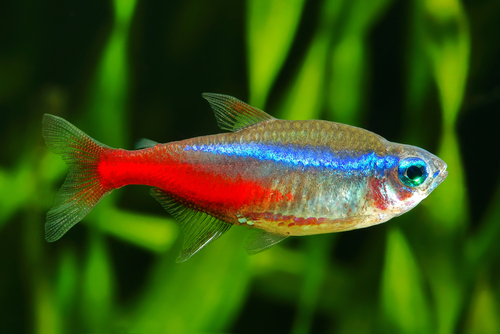
- Scientific Name: Paracheirodon innesi
- Adult Size: 1 inch
- Compatible With: Bristlenose Pleco
- Care Level: Medium Difficulty
- Origin: Peru, Southeastern Columbia, Brazil
This mid-dwelling little fish loves to show off it’s bright orangey-red and blue coloration, which looks downright neon in most lights. This is how this quirky little swimmer got it’s name. The neon tetra will be fine as a community fish as long as it has at least six or more of it’s own kind to school with.
Otherwise, the tetra is basically peaceful and will cause no harm at all to your bristlenose pleco, adding some color to the tank in the meantime.
Pros of keeping with Bristlenose Pleco:
- No aggression
- No food competition
Cons of keeping with Bristlenose Pleco :
- Needs at least 6 of it’s own kind to survive.
2. Zebra Danio
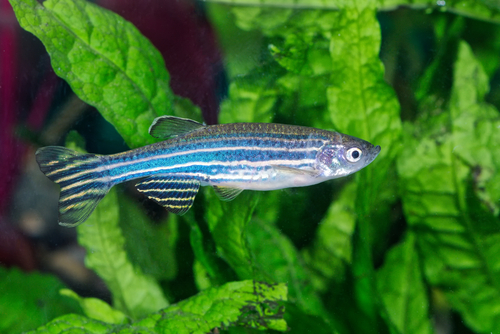
- Scientific Name: Danio rerio
- Adult Size: 2 inches
- Compatible With: Bristlenose Pleco
- Care Level: Easy
- Origin: India
The zebra danio’s personality is curious and energetic. However, this does not mean it is aggressive. The zebra danio is a mostly peaceful fish that also likes to live in schools of it’s own kind. Though it enjoys all levels of a tank, it will be no threat to a bristlenose pleco near the bottom.
Zebra danios are striped, giving them their name, and one of the most common colorations is also the most beautiful: a dark, iridescent blue striped through with sunset colors and bright, curious eyes!
Pros of keeping with Bristlenose Pleco:
- No aggression
- No food competition
Cons of keeping with Bristlenose Pleco :
- Needs at least 6 of its own kind to live with
3. Glass Catfish
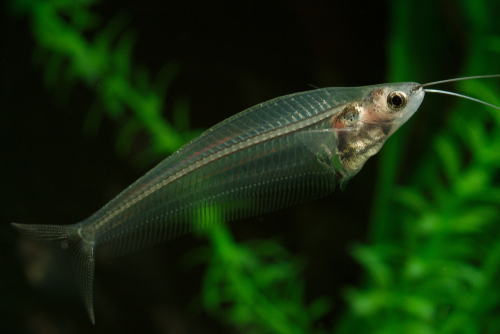
- Scientific Name: Kryptopterus bichirrhis
- Adult Size: 4 to 6 inches
- Compatible With: Bristlenose Pleco
- Care Level: Easy
- Origin: India
This is one of the most interesting tank mates you can get for a bristlenose pleco! The glass catfish is almost completely transparent all through it’s body, so you have the eerie but cool experience of watching little living fish skeletons swim around the tank!
These transparent fish are peaceful and can be found in the same places in the wild as the bristlenose pleco, so they’ll feel right at home, especially with more than one of their own kind.
Pros of keeping with Bristlenose Pleco:
- No food competition
- No aggression
- Same habitat
Cons of keeping with Bristlenose Pleco :
- None!
4. Guppy
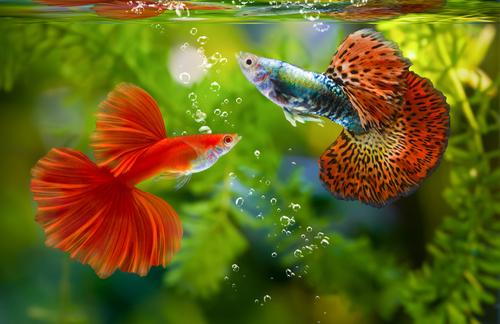
- Scientific Name: Poecilia reticulata
- Adult Size: 2 inches
- Compatible With: Bristlenose Pleco
- Care Level: Easy
- Origin: South America
The bristlenose pleco will have no trouble from this South American little fish, especially because it spends most of its time swimming around the top or middle of the aquarium. This fish is popular for its huge variety of colors, too.
They breed quickly and efficiently, so it is common for tank owners who are not careful to find several more guppies in their tank than they planned for because they love being in a school. That being said, these are social but peaceful fish!
Pros of keeping with Bristlenose Pleco:
- No food competition
- No aggression
Cons of keeping with Bristlenose Pleco :
- None!
5. Hatchetfish

- Scientific Name: Carnegiella strigata
- Adult Size: 1 inch
- Compatible With: Bristlenose Pleco
- Care Level: Difficult
- Origin:Peru, Bolivia, Brazil, Columbia
Hatchetfish are likely named for their blade-shaped bodies. They tend to like living near the top of their tank, and in the wild they are noted for leaping out of the water and flying through the air! In captivity, however, they are less likely to cause trouble in this way.
Hatchetfish are not happy unless they are in a group of ten of their own kind, or more, which is called “shoaling.” They sometimes fight one another, but this is usually just for fun and they refrain from injuring each other.
Pros of keeping with Bristlenose Pleco:
- No aggression
- No food competition
Cons of keeping with Bristlenose Pleco :
- None!
6. Silver Dollar

- Scientific Name: Mytennis argentus
- Adult Size: 6 inches
- Compatible With: Bristlenose Pleco
- Care Level: Medium Difficulty
- Origin: Guyana, Brazil
A silver dollar fish is named for its nearly round, reflectively silver appearance. The silver dollar fish is not likely to cause any trouble for the bristlenose pleco despite its large size, because it mainly eats plants as an herbivore.
Silver dollars are not only beautiful, but offer visual interest because they like to stay in groups of six or more.
Pros of keeping with Bristlenose Pleco:
- No food competition
- No aggression
Cons of keeping with Bristlenose Pleco :
- None!
7. Arowana
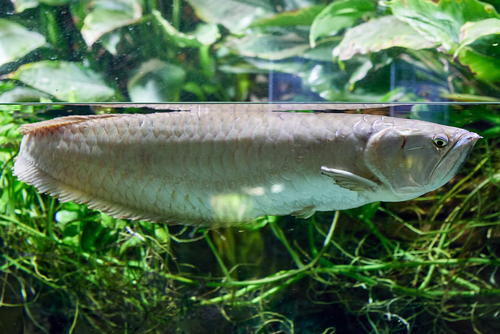
- Scientific Name: Osteoglossum bichirrhosum
- Adult Size: 3 to 4 feet
- Compatible With: Bristlenose Pleco
- Care Level: Difficult
- Origin: Peru, Columbia
This fish is very large, and aggressive, which can seem like a reason to keep them out of your peaceful, smaller bristlenose pleco’s tank. However, the truth is, the arowana loves to stay at the top of the aquarium, and is unlikely to bother the bristlenose pleco.
Arowana fish come in different color classifications, but the most well-known is silver with a yellowish bar stripping one side. They don’t like to be kept with more of their own kind.
Pros of keeping with Bristlenose Pleco:
- Stays in a different zone of the tank
Cons of keeping with Bristlenose Pleco :
- Can be difficult to feed, as they are picky eaters.
- Can be aggressive with other top-dwelling fish, though not bristlenose plecos.
8. Bamboo Shrimp
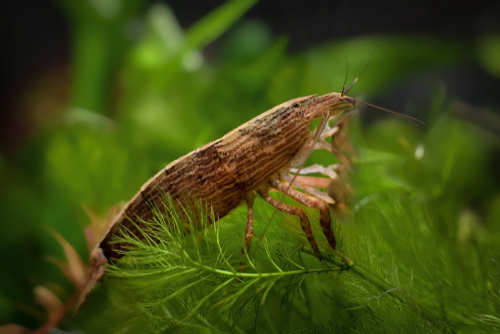
- Scientific Name: Atyopsis moluccensis
- Adult Size: 2 to 3 inches
- Compatible With: Bristlenose Pleco
- Care Level: Easy
- Origin: Asia
When it comes to shaking up the way your aquarium community looks altogether, try a shrimp instead of a fish! The bamboo shrimp is larger than some other aquarium shrimp, but it is a gentle giant. It will cause no harm to your bristlenose pleco, nor will it be intimidated as long as it has plenty of room and plants to climb on.
All in all, this shrimp will keep your pleco company with no trouble near the bottom of the tank!
Pros of keeping with Bristlenose Pleco:
- No aggression
- No food competition
Cons of keeping with Bristlenose Pleco :
- None!
9. Mystery Snail
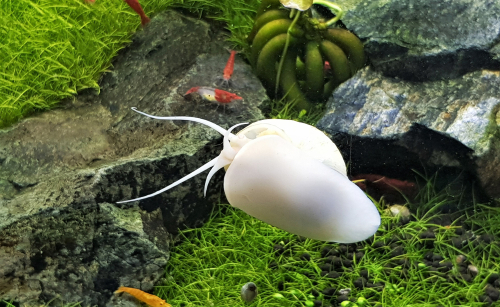
- Scientific Name: Pomacea bridgesii
- Adult Size: 1 ½ inches
- Compatible With: Bristlenose Pleco
- Care Level: Easy
- Origin: Asia
Speaking of visual variety, you can’t go wrong with a Mystery Snail! These snails are small and may not move much, but they will help the bristlenose pleco to clean up the tank with little to no issues.
Mystery snails are typically beautiful in coloration, too. Unlike the drab brown bristlenose pleco, a Mystery Snail adds a spot of golden sunshine to your tank!
Pros of keeping with Bristlenose Pleco:
- No food competition
- No aggression
Cons of keeping with Bristlenose Pleco :
- None!
10. Black Ghost Knife Fish
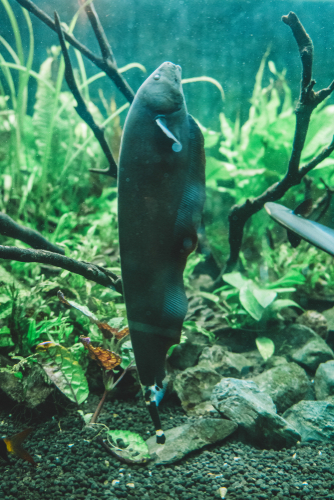
- Scientific Name: Apteronotus albifrons
- Adult Size: 18 to 20 inches
- Compatible With: Bristlenose Pleco
- Care Level: Easy
- Origin: South America
This fish should definitely get points for it’s cool name alone, but it backs this up with an equally interesting physical appearance! Not only can this fish get incredibly large, but it is shaped much like a long, dull blade with an almost mammallian, cute face.
This fish is carnivorous, but it likes to hide during the day and hunt at night. They are generally shy and peaceful, and only eat fish much smaller than themselves. With enough space to choose from, the black ghost knife fish and bristlenose pleco will leave one another alone.
Pros of keeping with Bristlenose Pleco:
- No aggression
- No food competition
Cons of keeping with Bristlenose Pleco :
- Needs plenty of room to coexist.
11. Clown Loach
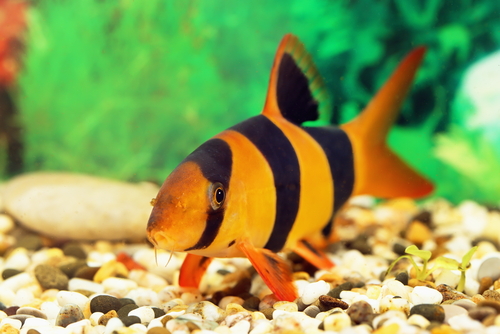
- Scientific Name: Botia macracantha
- Adult Size: 12 inches
- Compatible With: Bristlenose Pleco
- Care Level: Medium difficulty
- Origin: Indonesia
Clown loaches are typically thought of as beautiful and popular little rays of sunshine to have in your aquarium. They liven the place up with their orange and white stripes.
These fish love to play and chase one another around the tank, meaning they should be in schools of at least five of their own kind. They are peaceful, however, and will not cause issues for your bristlenose pleco.
Pros of keeping with Bristlenose Pleco:
- No aggression
- No food competition
Cons of keeping with Bristlenose Pleco :
- None!
12. Nerite Snail
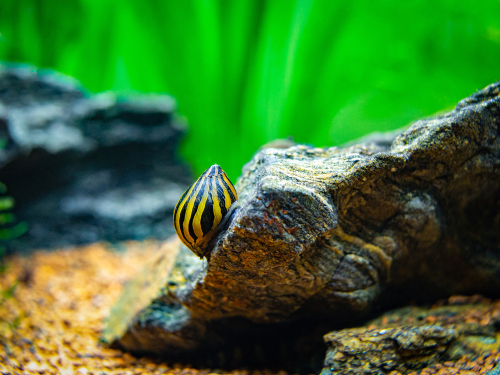
- Scientific Name: Nerita
- Adult Size: ½ to 1 inch.
- Compatible With: Bristlenose Pleco
- Care Level: Easy
- Origin: South Africa, Mazmbique, Tanzania, Kenya, Somalia
Nerite snails are another type of snail that can change up the way your tank of fish looks without disturbing the bristlenose pleco. They are typically in small shells of brown striped with yellow, making for a pleasing array of color, too!
Just be sure not to combine snail-eating fish like the clown loach with this small breed of snail, and your bristlenose pleco should have another snail buddy to share the lower part of the tank with!
Pros of keeping with Bristlenose Pleco:
- No aggression
- No food competition
Cons of keeping with Bristlenose Pleco :
- None!
13. Betta Fish
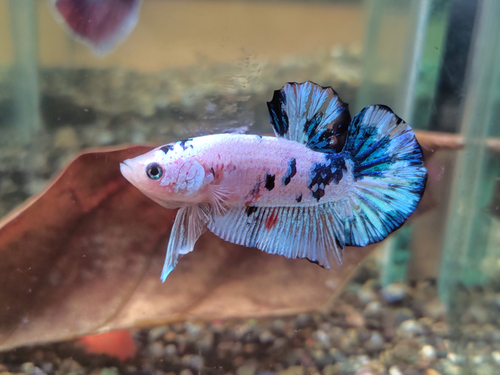
- Scientific Name: Betta splendens
- Adult Size: 3 inches
- Compatible With: Bristlenose Pleco
- Care Level: Easy
- Origin: Asia
Everyone has heard of these fighting fish and their beautiful fins! Bettas are popular not only for their beauty, but for their personalities, too. Though they can’t be kept with their own kind, they are peaceful when it comes to interacting with bristlenose plecos.
This is because betta fish like to stay in their own part of the tank without drifting down toward the bristlenose pleco’s lower territory. They come in all different varieties of lovely colors and patterns, which makes your options seem nearly unlimited!
Pros of keeping with Bristlenose Pleco:
- No aggression
- No food competition
Cons of keeping with Bristlenose Pleco :
- Can’t be kept with others of it’s kind
14. Molly
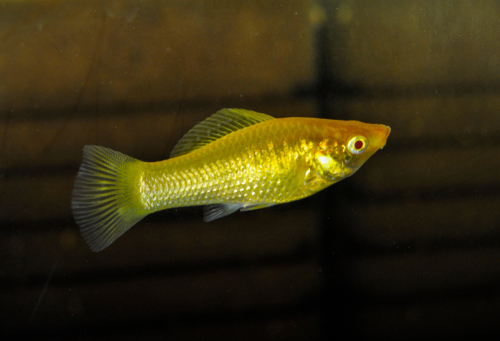
- Scientific Name: Poecilia sphenops
- Adult Size: 3 ½ to 6 inches
- Compatible With: Bristlenose Pleco
- Care Level: Easy
- Origin: Central America, Southern United States
Mollies come in several different breeds and varieties, but for the most part, all mollies thrive in the same conditions as bristlenose plecos and therefore make good tank mates.
Not only that, but these fish are typically peaceful as long as they have enough space of their own. They should also be kept with four or six of their own kind, but remember, they become aggressive without enough space!
Pros of keeping with Bristlenose Pleco:
- Not aggressive as long as they have enough room
- No food competition
Cons of keeping with Bristlenose Pleco :
- None!
15. Platy

- Scientific Name: Xiphophorus maculatus
- Adult Size: 2 inches
- Compatible With: Bristlenose Pleco
- Care Level: Easy
- Origin: Central America, North America, Mexico
Platies are another type of small fish that, much like Mollies, really refer to a whole category of beautiful little swimmers. Platies not only make great community fish because they’re easy to care for, but they are fun to watch!
They are peaceful, but love to be active as long as they have a few of their own kind and plenty of plants to feel safe in.
Pros of keeping with Bristlenose Pleco:
- No aggression
- No food competition
Cons of keeping with Bristlenose Pleco :
- None!
In Conclusion
To sum it all up, the 15 Best Bristlenose Pleco Tank Mates are all fish that match the pleco’s peaceful nature without disturbing it’s place feeding at the bottom of the tank. Some of these include platies, mollies, and even the dashing black ghost knife fish! To add variety to the tank, you can even try a snail or shrimp. You’ll have a beautiful tank in no time.

Ian Sterling, founder of Fishlab.com, began his aquarium journey over 30 years ago, driven by a deep fascination for fish and their diverse personalities. His website, Fishlab.com, is dedicated to making fishkeeping accessible and enjoyable, offering beginner-friendly guidance, expert insights, and a community for aquarists to connect and share experiences.


